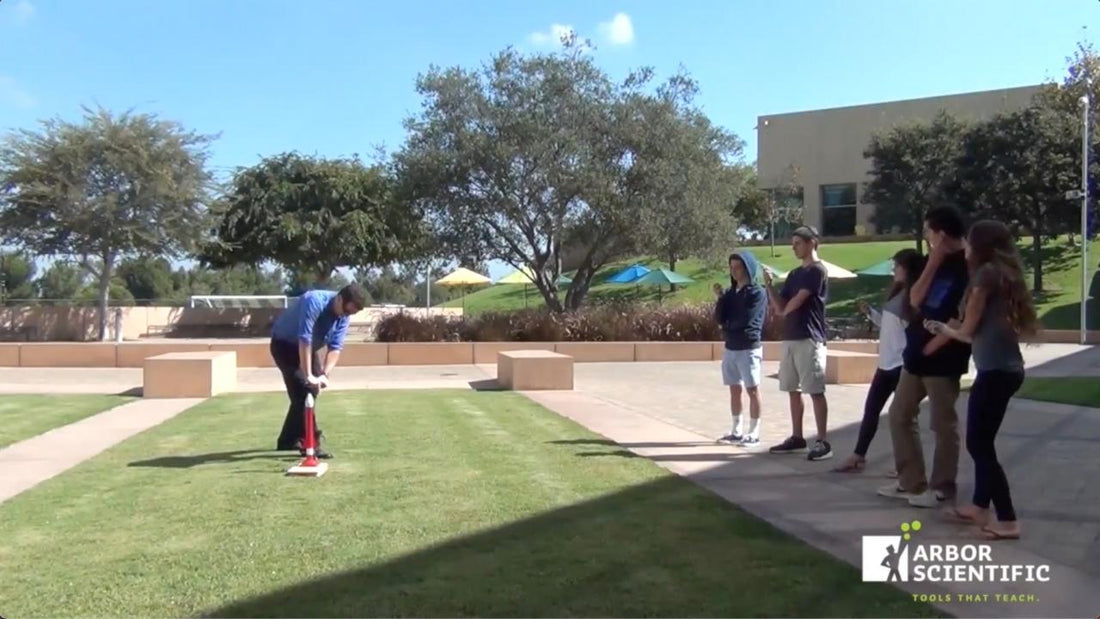Featured Products
Air Powered Projectile: An In-Depth Look
One of the best ways to engage your students in the study of projectile motion is with direct experiment and observation. For this purpose I recommend the air-powered projectile. It safely and reliably demonstrates projectile motion by simply releasing compressed air. Here are five experiments to get you started.
The soft nose cone provides a high degree of safety while the body's sleek design minimizes the effects of air resistance.
MEASURE LAUNCH VELOCITY
The first thing you want to do is determine the launch velocity by shooting straight up. It takes about 5 seconds to go up and come back down when shot vertically. Use the formula v=vo+at , analyze the top of the trajectory. At this point velocity = zero. Then set gravity to negative 10m/s/s. Gravity is pulling opposite the initial launch velocity, which is the unknown. Plugging in 2.5 seconds for time (assuming the trip takes the same time up as down) we get a launch velocity of about 25m/s. You might be concerned whether this is a safe speed, but the soft nose cone, and the fact that there is no chemical propellant ensures this. You may wish to wear safety goggles anyways.
The calculation of launch velocity is straight forward, requiring only algebra.
Sample data for the Range vs Angle Experiment. Note the systematic error on the zero.
ANGLE vs RANGE
A classic experiment that I have done every year since I started teaching is to investigate which angle generates the greatest launch distance. Students will have their own hypothesis. Without doing any math, try to hypothesize which angle will maximize the range. This is an experiment that works in both high school and middle school. The theoretical result is that 45 degrees maximizes range.
This is because the product of horizontal velocity and time in the air, which varies directly with vertical velocity, is maximized. The mathematical proof is a common homework problem in Honors Trigonometry classes and can be done without calculus. When you plot the data, a surprising result is that the complementary angles, like 30 and 60 degrees can have the same range as each other. This is because when the velocity is more horizontal, the vertical time is lessened, and vice versa.
When performing this experiment, it is helpful to use the angled wooden wedges option. These help adjust the angle without the use of clumsy blocks of wood or coupling. Another addition you might want to invest in are the varied speed washers. The different size caps affect the pressure limit that causes the seal to slip, launching the tube upward with the force of expanding gas. Larger washers can capture more of that force so it will go faster. This adds another variable which allows you to make new predictions. But with the same washers, you get the same time, every time.
Angled Wooden Wedges help a lot in this experiment. The angle of launch will be the compliment to these angles.
Different sized washers can change the launch velocity, adding a new variable.
ADIABATIC EXPANSION
The air rocket does not use any chemicals to launch. It only uses the compressed air of a bike pump, typically around 60 psi (pounds/square inch). When you launch the projectile, you will usually see some clouds appearing beside the base. They only last for a second, but can be made more visible by using a high speed camera. (Many students now have these in their smartphones.)
The clouds are caused by the humidity in the air being turned into a vapor due to the rapid temperature change. When a gas expands rapidly, it cools. This is called adiabatic expansion. It is an important idea in thermodynamics and this is a really good example of it. You've probably seen it when you open a champagne bottle, or even a soda.
Because the force of launch only acts in the initial moment, the rocket is an excellent example of a free falling projectile (unlike missiles and rockets). The sleek profile minimizes air resistance and turbulence while increasing the accuracy of the experiment.
Adiabatic clouds appearing during a typical launch event.
HIGHLY ACCURATE CALCULATED LANDING SITES
In video we launch the air powered projectile at 30 degrees, and from the first experiment, we already know the initial velocity, Vo=25m/s. We use Vo sin30 to find the initial upward velocity (12.5m/s) and Vo cos30 to find the horizontal component (21.6 m/s).
At the highest moment, it is only moving horizontally, so we once again can use v=vo+at. Only this time the plug step is 0=12.5-10t giving a time of 1.25 seconds to reach the top. Twice that is 2.5 seconds, the total time of flight.
The product of the horizontal component and the total time of flight is the distance traveled. (The horizontal velocity never changes.) The range, x=vhoriz * time = 21.6m/s * 2.5 sec = 54 m.
That the theoretical prediction. Take it with you, and some measuring tape (or the yard lines on the football field) and see what really happens.
When we did the experiment we got a result of 56 meters. That is less than 4% error, very good!
A typical projectile motion problem can now be performed experimentally, with a high degree of accuracy and while being highly engaging.
The impact location proves to be within 2 meters of the expected value.
James Lincoln
Tarbut V' Torah High School
Irvine, CA, USA
James Lincoln teaches Physics in Southern California and has won several science video contests and worked on various projects in the past few years. James has consulted on TV's "The Big Bang Theory" and WebTV's "This vs. That" and the UCLA Physics Video Project.
Contact: James@PhysicsVideos.net


